Refer:- IS 18001:2007
Fire and explosive hazards include combustible and flammable liquids and substances, and/or when hot work is performed. Fire and explosion can occur when the temperature has reached the flash point of the volatile material, and where there is sufficient vapour present in the atmosphere.
Understanding Fire and Explosion Hazards:
1. Causes of Fire and Explosion Hazards:
Flammable Liquids and Gases: Substances like gasoline, solvents, and natural gas can ignite easily when exposed to an ignition source.
Combustible Dust: Fine particles from materials such as wood, grain, sugar, and metal can form explosive dust clouds when suspended in the air.
Electrical Hazards: Faulty wiring, overloaded circuits, or static electricity can generate sparks that ignite flammable materials.
Chemical Reactions: Certain chemicals can react violently when mixed or exposed to heat, causing fires or explosions.
2. Consequences of Fires and Explosions:
Injury and Fatalities: Employees can suffer burns, inhalation injuries, and trauma from blast impacts.
Property Damage: Fires and explosions can destroy buildings, machinery, and valuable assets.
Operational Disruption: Businesses may face significant downtime, leading to financial losses and production delays.
Environmental Impact: Hazardous substances released during incidents can contaminate air, water, and soil.
Strategies for Mitigating Fire and Explosion Hazards:
1. Hazard Identification and Risk Assessment:
Conduct Regular Inspections: Inspect facilities for potential fire and explosion hazards, such as flammable material storage areas, electrical equipment, and dust accumulation points.
Risk Assessments: Evaluate the likelihood and potential severity of incidents to prioritize mitigation efforts.
2. Implementing Engineering Controls:
Ventilation Systems: Install proper ventilation to reduce the concentration of flammable vapors and dust.
Explosion-Proof Equipment: Use equipment and electrical systems designed to prevent ignition in hazardous areas.
Automatic Suppression Systems: Implement fire suppression systems, such as sprinklers and gas-based extinguishing systems.
3. Administrative Controls:
Safety Training: Train employees on fire and explosion hazards, safe handling of materials, and emergency response procedures.
Permitting Systems: Implement hot work permits for activities that could ignite fires, such as welding or cutting.
Housekeeping: Maintain cleanliness to prevent dust accumulation and ensure proper storage of flammable materials.
4. Personal Protective Equipment (PPE):
Flame-Resistant Clothing: Equip employees with clothing that reduces burn injuries.
Respiratory Protection: Use respirators to protect against inhalation of toxic fumes or dust.
Eye and Face Protection: Provide goggles or face shields to guard against flash burns and flying debris.
5. Emergency Response Planning:
Emergency Action Plans (EAP): Develop and communicate clear plans outlining evacuation routes, assembly points, and emergency contact information.
Regular Drills: Conduct fire and explosion drills to ensure employees know how to respond effectively.
Coordination with Emergency Services: Establish relationships with local fire departments and emergency responders.
